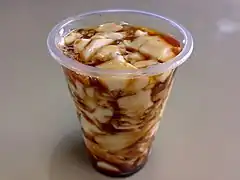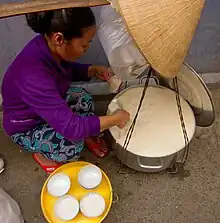 Douhua in sugar syrup | |
| Alternative names | Doufuhua, doufunao, laodoufu, tofu pudding, soybean pudding |
|---|---|
| Type | Snack |
| Place of origin | China |
| Region or state | East Asia and Southeast Asia |
| Main ingredients | Tofu |
| tofu pudding | |||||||||||||||||||||
|---|---|---|---|---|---|---|---|---|---|---|---|---|---|---|---|---|---|---|---|---|---|
| Chinese | 豆腐花 | ||||||||||||||||||||
| Literal meaning | bean curd flower | ||||||||||||||||||||
| |||||||||||||||||||||
| Alternative Chinese name | |||||||||||||||||||||
| Traditional Chinese | 豆花 | ||||||||||||||||||||
| Simplified Chinese | 豆花 | ||||||||||||||||||||
| |||||||||||||||||||||
| Second alternative Chinese name | |||||||||||||||||||||
| Traditional Chinese | 豆腐腦 | ||||||||||||||||||||
| Simplified Chinese | 豆腐脑 | ||||||||||||||||||||
| |||||||||||||||||||||

Douhua (Chinese: 豆花; pinyin: dòuhuā; Pe̍h-ōe-jī: tāu-hoe) is a Chinese sweet or savoury snack made with silken tofu. It is also referred to as doufuhua (Chinese: 豆腐花; pinyin: dòufuhuā), tofu pudding,[1] soybean pudding[2] or, particularly in northern China, tofu brains (Chinese: 豆腐脑; pinyin: dòufunǎo).[3]
History
Tofu is thought to have originated in ancient China during the Han Dynasty. Liu An, the grandson of Emperor Gaozu of Han, was ambitious and wanted to invent something to make people live forever. Even though he failed to make the magic pill, he used soybean and bittern to finally get niveous and tender tofu, which was surprisingly tasty. People named it "tofu brains" because of its softness. Tofu brains then became a popular snack during Han Dynasty.[4] In the next 2000 years, it gradually spread throughout China. [5]
During the Second Sino-Japanese War, Sichuan became the political, economical, and military center of China. The boss of a famous Douhua restaurant, Liu Xilu, learnt the methods of making beancurd from others and innovated on them until he finally came up with his own "secret recipe", which greatly improved its taste.
Names
| Douhua | 豆花 | Taiwan, Sichuan, Yunnan, Guizhou, Hunan, Jiangxi, Fujian; in northern China, douhua refers exclusively to sweet variants | In Fujian, brown sugar is added to sweet Douhua, while salted Douhua is flavored with dried radish, fried garlic, cilantro, dried shrimps, etc. In Taiwan, beans such as mung bean, red beans, and peeled peanuts are usually added, as well as soy milk, fruit, or taro balls. |
| Doufuhua | 豆腐花 | Southern China, Hong Kong, Macau, Malaysia, Singapore | In Hong Kong and Macau, brown sugar, sweet-scented osmanthus syrup, and ginger juice are usually added to Douhua. Chili oil or powder is normally added to it in southwest China. |
| Doufunao | 豆腐脑 | North China, Hubei, Anhui, Jiangsu, Henan, Shanghai, Zhejiang | Northern doufunao (lit. "tofu brains") are often seasoned with "salted stew", and Henan people usually eat it with local snacks. Tofu brains in Jiangsu, Zhejiang, and Shanghai are generally salty tofu brains like the northern ones. People in Hubei and Anhui also call it as tofu brain, but tofu brain in Hubei is generally added with white sugar, which is the sweet version. |
| Laodoufu | 老豆腐 | Tianjin | In Tianjin cuisine, Northern-style savoury "tofu brain" is a common breakfast item known as laodoufu (old tofu). |
| Doufusheng | 豆腐生 | Taizhou, Zhejiang | Sweet Douhua there is topped with syrup and some sweet-scented osmanthus; the salty one is topped with mustard tuber, seaweed, spring onion, etc. |
| Nendoufu | 嫩豆腐 | Hubei | In Hubei, people call spicy Douhua "silk tofu." |
Regional variants
Variants of douhua can be broadly divided into three groups: savoury (鹹), spicy (辣) and sweet (甜).
There are three main ways to eat bean curd: sweet, salty, and spicy. Traditionally, sweet foods were mainly distributed in South China and Hong Kong, and were introduced to Taiwan and Southeast Asia; salty foods were mainly distributed in northern China, and spicy foods were mainly distributed in southwest China.
Savoury
.jpg.webp)
In Northern China, Douhua is often eaten with soy sauce, thus resulting in a savory flavor. Northern Chinese often refer to douhua as tofu brains. Each region may differ in seasonings. Inland cities add chopped meat, pickles or zha cai, and mushrooms, while coastal cities add seaweed and small shrimp. Tofu brains can be found at breakfast stands along the streets in the morning, usually with eggs or youtiao (fried dough sticks). Other times it is hard to find outside of a restaurant.[6]
Spicy

In Sichuan and neighboring Shaanxi, douhua is often flavored with chilli oil and Sichuan peppers to make it spicy. It is served by carrying pole or bicycle vendors with several condiments such as chili oil, soy sauce, scallions, and nuts. A famous Sichuan dish, spicy tofu fish (豆花鱼) uses douhua as an essential ingredient.
Sweet
In Hubei, Hunan and Jiangxi, sugar is added directly to the tofu curd without adding any other condiments. This way of eating best retains the original flavor of tofu curd (bean curd).

In Southern China, Douhua is often eaten with sweet flavoring. Southern China often refers to Douhua as tofu pudding. It is served with sweet ginger or clear syrup. In summer, people eat cold Douhua to relieve themselves of the heat. In winter, people add hot sweet water and beans into Douhua to dispel cold. Hong Kong people add sesame paste into Douhua.
Taiwanese and Cantonese douhua are a symbol of Southern Chinese cuisine, and often served as a part of yum cha.[7] Known as tofu fa, it can also be found sold in small stores on the side of popular hiking trails and beaches in Hong Kong. [8]

In Southeast Asia, douhua is almost always sweet, although condiments vary widely.
Filipino cuisine

In the Philippines, it is more commonly known as taho. It is a fresh silken tofu served in sweet brown syrup and sago pearls. It is usually peddled by hawkers in the mornings, by door-to-door or in public plazas, or outside churches. In some regional variations, taho is often served with sugarcane syrup, ube syrup or strawberry syrup.
Indonesian cuisine

In Indonesia, it is known as Kembang tahu or in Java as Tahwa derived from the Chinese Hokkien name Tau Hwe, or Wedang Tahu (ꦮꦺꦢꦁꦠꦲꦸ) (Wedang means hot beverage and Tahu means tofu in Javanese) and is usually sold by hawkers. It is served warm or cold with palm sugar syrup that has been flavored with pandan leaves and ginger.
Malaysian and Singaporean cuisine
In Malaysia and Singapore, it is more commonly known by its names tau hua or tau huay in Hokkien, or by the Cantonese name (tau fu fa), with the Cantonese variation being more common in Malaysia. In Penang, the common term is tau hua, due to Hokkien being its dominant local Chinese language. In Kelantan, the dish is known as pati soya (lit. 'soy essence').
It is usually served either with a clear sweet syrup alone, with ginkgo seeds suspended in the syrup, or in a sugar syrup infused with pandan. Alternatively, it can also be served with palm syrup (Gula Melaka).
Thai cuisine
In Thailand, it is known by its Chinese Hokkien name taohuai (เต้าฮวย). It is usually served cold with milk and fruit salad, which is known as taohuai nom sot (เต้าฮวยนมสด, literally "douhua in fresh milk") or taohuai fruit salad (เต้าฮวยฟรุตสลัด), or served hot with ginger syrup, which is known as taohuai nam khing (เต้าฮวยน้ำขิง).
Vietnamese cuisine


In Vietnam, it is known as tàu hủ nước đường, tàu hủ hoa or tào phớ, đậu hủ, tàu hủ. It varies in three regions in Vietnam:
- Northern region — served with jasmine infused sugary water. It is enjoyed as warm in winter and cold with ice in summer.
- Central region — cooked with spicy ginger. Sugar is added. Douhua pieces are usually unshaped because of their softness.
- Southern region — served warm with lychee and coconut water. Ginger is optional. Douhua pieces are firmer than those in the North and the Central.
Nutritional value and health benefits
Douhua is rich in nutrients, contains iron, calcium, phosphorus, magnesium and other trace elements necessary for the human body. It also contains sugar, vegetable oil, and high-quality protein. The digestion and absorption rate of tofu is more than 95%.
In addition to its function of increasing nutrition and helping digestion, tofu is also beneficial to the growth and development of teeth and bones. It can increase iron element in people's blood in the hematopoietic function; tofu does not contain cholesterol, which is very beneficial to people with hypertension, high blood lipids, hypercholesterolemia, arteriosclerosis, and coronary artery disease. It is a valuable food supplement for children and the elders.[9]
Tofu is rich in phytoestrogens as well, which has an effect on preventing and inhibiting osteoporosis, breast cancer, prostate cancer, and blood cancer. The sterols and stigmasterol in tofu are both effective ingredients for suppressing cancer.[10]
Packaged
The dessert is also sold in North American Asian supermarkets in plastic containers.
Requirements
Like all tofu, douhua must have a coagulant, often gluconolactone for smoothness as compared with other coagulants.
Tofu pudding made from agarwood, edible gum, and seaweed extracts is more like soy milk-flavored jelly pudding. Because it melts into liquid soy milk when heated, it can only be eaten at room temperature, but the success rate of making it is extremely high. It is high and easy, so it is widely used.
In popular culture
Tofu pudding was featured on the Netflix TV series, Street Food, in the Chiayi, Taiwan episode.[11]
See also
References
- ↑ "Tofu Pudding (Douhua)". China Sichuan Food. Archived from the original on 19 June 2020. Retrieved 28 September 2020.
- ↑ "SOYBEAN PUDDING WITH GINGER SYRUP (DOUHUA)". Cookmorphosis. Archived from the original on 11 November 2019. Retrieved 28 September 2020.
- ↑ "(豆腐脑 dòufu nǎo)". Into the Middle Kingdom. Archived from the original on 11 October 2015. Retrieved 28 September 2020.
- ↑ "豆花的饮食文化:历史由来". www.weibacanyin.com. Archived from the original on 2021-03-06. Retrieved 2020-12-06.
- ↑ "豆腐脑的来历". 29 September 2015. Archived from the original on 29 June 2021. Retrieved 29 June 2021.
- ↑ "豆腐脑市场价格多少钱一碗 单卖豆腐脑生意怎么样 - 致富热". www.zhifure.com. Retrieved 2020-12-09.
- ↑ "Tofu hwa (soybean pudding) is my favourite way of chilling with tofu | SBS Food". Archived from the original on 2021-11-01. Retrieved 2021-11-01.
- ↑ "Where to find the best tofu fa outside of Hong Kong Island". Retrieved 2023-09-27.
- ↑ "Tofu: Health benefits, uses, and possible risks". www.medicalnewstoday.com. 2017-09-27. Archived from the original on 2021-07-09. Retrieved 2021-07-01.
- ↑ Zhang, qinqin (30 March 2015). "早晨喝豆腐脑的营养更高". Archived from the original on 8 August 2015.
- ↑ Joshua Samuel Brown (22 May 2019). "Taiwan Culture and Cuisine Shine on New Netflix Series "Street Food"". CommonWealth Magazine. Commonwealth Magazin Group. Archived from the original on 20 December 2019. Retrieved 28 September 2020.

